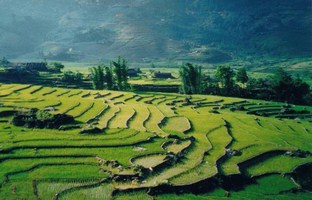Tripatini
the world's smartest travel social network
Sapa covers in the mists
Today, Sapa’s narrow streets are both temporary home and business place to the H’mong, Dao, Giay, Pho Lu, and Tay people, whose traditional ethnic dress marks them out from the multitude of nations who come to Sapa to lose themselves in its landscape.
Deep within the valleys and mountains of Vietnam’s furthest Northern reaches lies the remote hill town of Sapa. Most often viewed through the seemingly never ending carpet of mist, Sapa is a visual feast unmatched in Vietnam; on the one hand remote and distant and, on the other, searingly developed and commercial.
Certainly, part of Sapa’s aloof appeal must lie with the difficulty in reaching this former French hill station.
Disembarking from the overnight train from Hanoi at Lao Cai station, visitors are treated to their first taste of Sapa’s visual richness in the sometimes dizzying forty minute minibus ride to the market town itself. Just caught through the thick morning mist, glimpses can be snatched of mountains as rich and green as anywhere on earth, with valley walls tiered with rice paddies like enormous wedding cakes stretching out into the clouds.

Of course, it would be wrong to suppose that Sapa first found life through the arrival of Europeans, or even the Vietnamese. Rather, this area has long been home to the various hill people who still live and work within this breathtaking landscape.
The women of these groups - who still speak of ‘the Vietnamese’ - think little of walking the twenty five kilometers to Sapa, their handmade goods carried on their backs in traditional wicker baskets to barter and trade with tourists. The hill people have proved themselves remarkably astute businesspeople and, while they might struggle with literacy, a working knowledge of English, French and a smattering of other languages is well within their reach. The trade in handicrafts has been a relatively lucrative one for the hill people, their own internal economies seemingly now permanently skewed towards the tourist trade.
Sapa itself has also, quite literally, found new shape within the reflection of tourist’ expectations, it’s guesthouses and hotels lining the valley walls, each competing for the best views of the dazzling vista below. One unfortunate side effect of this competition for awe, has been the lax enforcement of the height limits at which buildings might be built to, leaving a nasty question mark over the future of Sapa’s already fading serenity.
However, if Sapa itself might be starting to give way in the face of advancing commercialism, its landscape remains stubbornly unflinching in the face of growing tourist numbers. Outside of Sapa, small boys ride their water buffaloes, the ethnic minorities work on their handicrafts and farmers toil in the gravity defying rice fields. There are endless ways of exploring the countryside of Sapa. However, one of the most rewarding can be to hire a local guide, often from one of the ethnic minority groups, who know all the places your guidebook has never have heard of.
Most guides, by their very nature, are also skilled mountaineers and are just at ease taking visitors on a three day ascent of Fansipan as they are taking them around Sapa’s surrounding villages. Alternatively, for those who prefer to immerse themselves in nature’s bounty with their knuckles white, there are any number of outlets offering cheap motorbike rental.
Commercial interests and the ever expanding appetites of 21st Century tourism may be starting to take their toll on Sapa, but the town itself, its people and its breathtaking scenery remain a highpoint on any Vietnam itinerary. See it while you can.
Videos
Groups
-
India
173 members
-
Tour Operators
873 members
-
Ireland
93 members
-
South Dakota
17 members
-
Azerbaijan
17 members
-
Shopping the World
55 members
-
Tech for Travel/Hospital…
87 members
-
Andorra
26 members
-
Online Corner
75 members
-
Minnesota
22 members
-
Backpackers & Hostels
84 members
-
Portugal
60 members
-
Turks and Caicos
26 members
-
Agritourism/Farmstays
72 members
-
Zambia
21 members
© 2025 Created by EnLinea Media.
Powered by
![]()
Badges | Report an Issue | Privacy Policy | Terms of Service
You need to be a member of Tripatini to add comments!
Join Tripatini